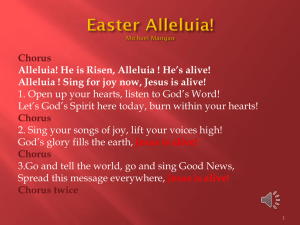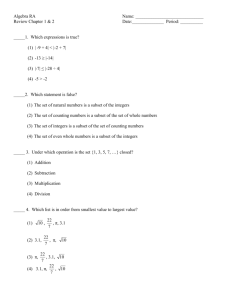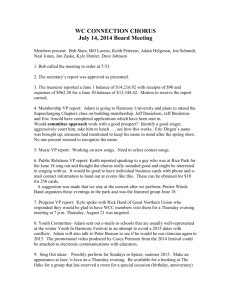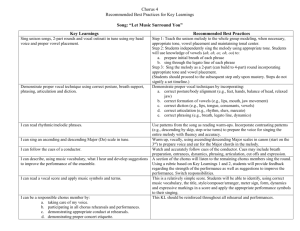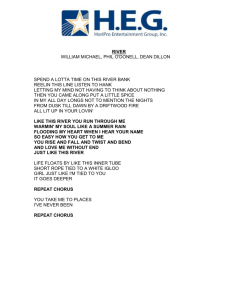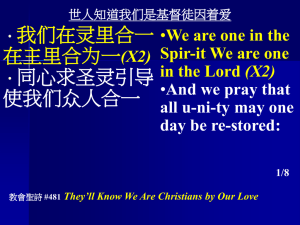MS Word 97 format ()
advertisement
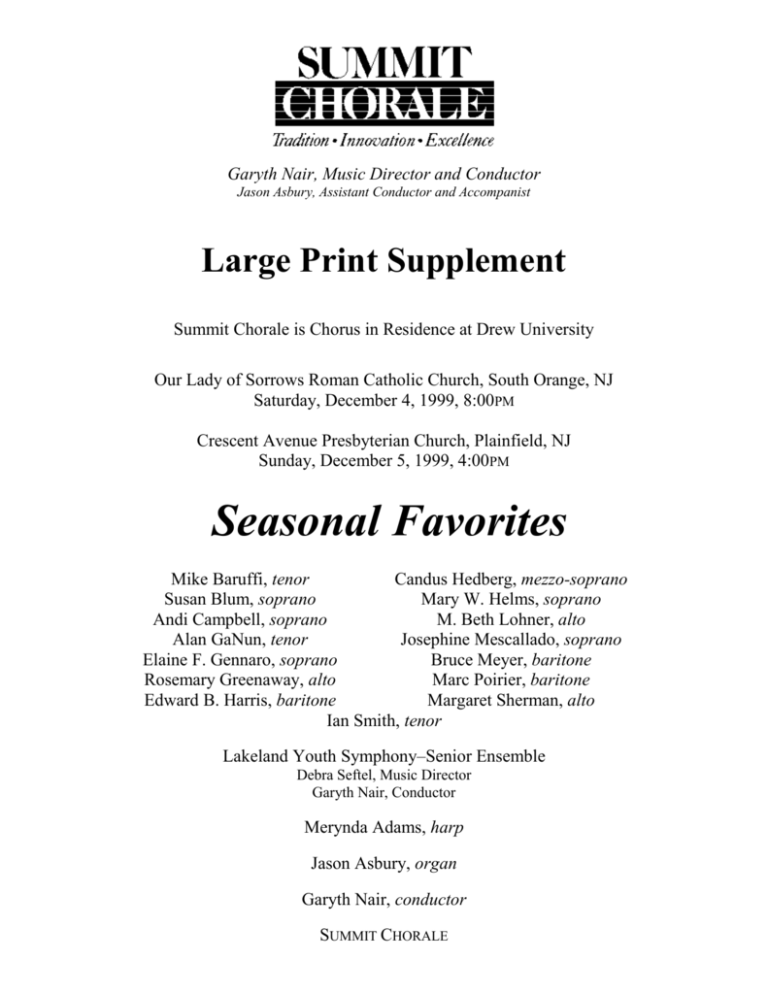
Garyth Nair, Music Director and Conductor Jason Asbury, Assistant Conductor and Accompanist Large Print Supplement Summit Chorale is Chorus in Residence at Drew University Our Lady of Sorrows Roman Catholic Church, South Orange, NJ Saturday, December 4, 1999, 8:00PM Crescent Avenue Presbyterian Church, Plainfield, NJ Sunday, December 5, 1999, 4:00PM Seasonal Favorites Mike Baruffi, tenor Candus Hedberg, mezzo-soprano Susan Blum, soprano Mary W. Helms, soprano Andi Campbell, soprano M. Beth Lohner, alto Alan GaNun, tenor Josephine Mescallado, soprano Elaine F. Gennaro, soprano Bruce Meyer, baritone Rosemary Greenaway, alto Marc Poirier, baritone Edward B. Harris, baritone Margaret Sherman, alto Ian Smith, tenor Lakeland Youth Symphony–Senior Ensemble Debra Seftel, Music Director Garyth Nair, Conductor Merynda Adams, harp Jason Asbury, organ Garyth Nair, conductor SUMMIT CHORALE PROGRAM I Oratorio de Noël, Op. 12 Camille Saint-Saëns (1835–1921) 1. Prélude 2. Récit et Chœr soli: Mr. Smith, Ms. Lohner, Ms. Campbell, Mr. Meyer 3. Air solo: Ms. Lohner 4. Air et Chœr solo: Mr. Baruffi 5. Duo: Benedictus soli: Ms. Campbell, Mr. Meyer 6. Chœr 7. Trio soli: Mr. GaNun, Ms. Blum, Mr. Poirier 8. Quatuor soli: Ms. Lohner, Mr. Meyer, Ms. Campbell, Ms. Hedberg 9. Quintette et Chœr soli: Mr. GaNun, Ms. Gennaro, Ms. Hedberg, Ms. Greenaway, Mr. Meyer — INTERMISSION — II Joy to the World! In the Bleak Midwinter arr. Garyth Nair Gustav Holst, arr. Garyth Nair soli: Ms. Mescallado, Mr. Harris Interlude from A Ceremony of Carols Benjamin Britten (1913–1976) harp solo: Ms. Adams Angels We have Heard on High Masters in This Hall arr. Garyth Nair arr. David Willcocks III Audience carol sing IV From St. Paul’s Suite Gustav Holst (1874–1934) 4. Finale (The Dargason) Lakeland Youth Symphony–Senior Ensemble Stille Nacht Franz Gruber, arr. John Rutter trio: Ms. Gennaro, Ms. Helms, Ms. Sherman The Little Drummer Boy Ding Dong! Merrily on High Echo Carol Fantasy arr. Roger Wagner (transcription G. Nair) arr. David Willcocks Garyth Nair (1943–) SUMMIT CHORALE appeals to parents to assist their children in developing courteous audience behavior. ••• Please do not use cameras requiring flash during the performance. ••• Please turn off all electronic noisemakers, including pagers, cell phones, wristwatch alarms and the like which may disturb other audience members during the performance. ••• The use of recording equipment, including audio and video recorders, is strictly prohibited during the performance. ••• Please refrain from smoking anywhere in this building. Funding has been made possible in part by the New Jersey State Council on the Arts through a grant administered by the Union County Division of Cultural and Heritage Affairs. Additional funding has been provided through a grant from The Frank & Lydia Bergen Foundation. Questions? Want more information about SUMMIT CHORALE? Call (973) 762–8486 write us P.O. Box 265; Summit, NJ 07902-0265 or visit us online http://www.summitchorale.org TRANSLATIONS Oratorio de Noël [Christmas Oratorio] No.2: Récit et Chœr Et pastores erant in regione eadem vigilantes, Et custodientes vigilias noctis super gregem suum. Et ecce angelus Domini stetit juxta illos, Et claritas Dei circumfulsit illos, Et timuerunt timore magno. Et dixit illis angelus: “Nolite timere: Ecce enim evangeliso vobis gaudium magnum quod erit omni populo: Quia natus est vobis hodie Christus Dominus, in civitate David. Et hoc vobis signum: Invenietis infantem pannis involutum, et positum in præsepio.” No.2: Recitative and Chorus And in that same region there were shepherds out in the fields, keeping watch over their flock by night. And, behold, an angel of the Lord appeared to them, and the glory of the Lord shown ’round about them, and they were filled with great fear. And the angel said to them: “Fear not: for behold I bring you good tidings of great joy, which will be to all people. For to you is born today Christ the Lord, in the city of David. And this will be a sign for you: you will find a babe wrapped in swaddling clothes and lying in a manger.” Et subito facta est eum angelo multitudo militiæ cælestis Laudantium Deum, et dicentium: And suddenly there was with the angel a multitude of the heavenly host, praising God and saying: “Gloria in altissimis Deo. Et in terra pax hominibus bonæ voluntatis.” “Glory to God in the highest, and on earth, peace to men of good will.” No. 3: Air Expectans, expectavi Dominum: Et intendit mihi. No. 3: Air I have waited patiently for the Lord, and he has hearkened to me. No. 4: Air et Chœr Domine, ego credidi quia tu es Christus Filius Dei vivi. Qui in hunc mundum venisti. No. 4: Air and Chorus Lord, I believe that you are the Christ, the Son of the Living God, who has come into the world. No. 5: Duo: Benedictus Benedictus qui venit in nomine Domini. Deus Dominus, et illuxit nobis. Deus meus es tu, et confitebor tibi. Deus meus es tu, et exaltabo te. No. 5: Duet: Bendiction Blessed is he who comes in the name of the Lord. The Lord is God, and He has shown His light upon us. You are my God, and I will trust in you. You are my God, and I will exalt you. No.6: Chœr Quare fremuerunt gentes? Et populi meditati sunt inania? No. 6: Chorus Why do the nations rage, and why do the peoples imagine vain things? Gloria Patri, gloria Filio, gloria Spiritui Sancto; Sicut erat in principio, et nunc et semper, Et in sæcula sæculorum. Amen. Glory to the Father, glory to the Son, glory to the Holy Spirit. As it was in the beginning, is now, and will be forever and ever. Amen. … continued … No.7: Trio Tecum principium in die virtutis tuæ In splendoribus Sanctorum. No. 7: Trio With you is dominion on the day of your strength, amidst the splendor of your saints. No.8: Quatuor Alleluia. Laudate, cœli, et exulta, terra, Quia consolatus est Dominus populum suum; Et pauperum suorum miserebitur. No. 8: Quartet Alleluia! Let the heavens sing for joy, and the earth rejoice, for the Lord has comforted his people. And he will have compassion on his afflicted. No.9: Quintette et Chœr Consurge, Filia Sion. Alleluia. Lauda in nocte, in principio vigiliarum. No. 9: Quintet and Chorus Arise, daughter of Zion! Alleluia! Sing praises in the night, in the first watch of the night. Egrediatur ut splendor justus Sion, Et Salvator ejus ut lampas accendatur. Alleluia. Until Zion’s righteousness goes forth as brightness, and her salvation as a burning lamp. Alleluia! Tollite hostias, et adora te Dominum in atrio sancto ejus. Lætentur cœli, et exultet terra, A facie Domini, quoniam venit. Alleluia. Bring offerings and worship the Lord in His holy house. Let the heavens rejoice and the earth be glad in the presence of the Lord, for he comes. Alleluia! Translation by William D. Stroker Stille Nacht [Silent Night] Stille Nacht! heilige Nacht! Alles schläft, einsam wacht Nur das traute, hochheilige Paar, Holder Knabe im lockigen Haar. Schlaf’ in himmlischer Ruh! Silent night! holy night! All is calm, all is bright ‘Round yon virgin mother and child, Holy infant so tender and mild, Sleep in heavenly peace! Stille Nacht! heilige Nacht! Hirten erst kund gemacht, Durch der Engel Halleluja Tönt es laut von fern und nah: Christ, der Retter, ist da! Silent night! holy night! Shepherds first saw the sight: Glories stream from heaven afar, Heav’nly hosts sing Alleluia! Christ the Savior is born! Stille Nacht! heilige Nacht! Gottes Sohn, O wie lacht Lieb’ aus deinem göttlichen Mund, Da uns schlägt die rettende Stund, Christ, in deiner Geburt! Silent night! holy night! Son of God, love’s pure light; Radiance beams from thy holy face, With the dawn of redeeming grace, Jesus, Lord, at thy birth! NOTES ON THE PROGRAM by Mary W. Helms In this concert SUMMIT CHORALE offers a single major work and a varied selection of shorter holiday fare to begin celebrating Garyth Nair’s thirtieth year as its Music Director and Conductor. I Born in Paris in 1835 and raised by his mother and her aunt, Camille Saint-Saëns was a child prodigy on the order of Mozart or Mendelssohn. He played Beethoven piano sonatas at private gatherings by age four, began to compose music before he was five, and presented Mozart and Beethoven concertos in a public debut concert when he was ten. Unlike Mozart, however, Saint-Saëns never had financial worries, and rather than pursuing the early fame sought by his piano teacher, he continued his education, both musical and general. As a result, he became a man of varied interests who published poetry, plays, and treatises on music, theatre, religion and philosophy as well as communicating with learned societies on such subjects as astronomy and acoustics. Saint-Saëns also delighted in learning about other countries and enjoyed giving concerts in Spain, Portugal, Italy, Greece, Scandinavia, Russia, England, Argentina, Uruguay, Ceylon, Vietnam, Egypt, the Canary Islands and the United States. He died in 1921, in one of his favorite cities, Algiers. Saint-Saëns began earning his living as a musician in 1852 when he was appointed organist at the Parisian church of SaintMerry. In 1857 he obtained the post of principal organist at the ultra-fashionable La Madeleine, with a magnificent new Cavaillé-Coll organ, a fine salary, and “the highest wedding fees in Paris.” He retained this position until 1877. It was here that, after hearing him improvise, Liszt hailed SaintSaëns as the greatest organist in the world. In 1861, Saint-Saëns ventured into teaching for several years at the École Niedermeyer, a school founded to improve French church music. His students included Gigout and Messager as well as Fauré, who became a lifelong close friend. In addition to his abilities as a composer and virtuoso organist, Saint-Saëns excelled as a conductor and as a pianist, notably in the works of Mozart. He once remarked, “I live in music like a fish in water.” He maintained an active career as composer and performer almost to the very end of his long and productive life. Saint-Saëns composed in every 19th century musical genre, and his output was prodigious. Composing came easily to him; he observed that he did it as naturally “as an apple tree produces apples.” Although he was once considered the greatest French composer, only a few of his works are familiar to audiences in this country today—the “Organ Symphony,” Samson et Dalila, Danse Macabre, Le Carnaval des Animaux and a handful of concertos. In his youth Saint-Saëns was considered something of a revolutionary; he championed the work of Schumann and Wagner when it was still controversial, and at a time when German and Austrian composers dominated French concert programs, he was one of the founders of the Société Nationale de Musique whose purpose was to encourage and perform new music by French composers. Of course it provided an opportunity to present his own work, and later it became especially important in introducing the next generation of French composers—who, in turn, considered Saint-Saëns a reactionary. His musical language remained conservative, embodying such characteristically French qualities as elegance, clarity and order. As the Viennese critic Hanslick wrote, “…everywhere in his works are found spirit, humour, many qualities of scholarship, and piquant vivacity of treatment. His compositions show excellent workmanship and extreme facility in dealing with all kinds of musical expression.” The Oratorio de Noël (Opus 12) comes from the early part of Saint-Saëns’ career, at a time when sacred music had been in decline— “a sad, decadent period of which only a wretched output remains,” as composer and organist Louis Vierne put it. Vierne went on to point out that in his sacred music, SaintSaëns “reacted strongly against the bad taste of the times by writing music strictly appropriate to the character of the liturgical words of the given text. He banished…all useless decoration and theatrical effects…to return to formal purity, true prosody and sound, solid writing.…His love for the voice is felt and he works hard to place it under the best possible conditions to make it clear and expressive.” At La Madeleine, Saint-Saëns was frequently required to compose for particular occasions and barely a year after his appointment he was commissioned to write an oratorio for Christmas. He began on December 4, 1858 and completed the work just eleven days later, in time for rehearsal before the first performance on Christmas Eve. It was officially titled “Oratorium pro nocte Nativitatis Christi” and dedicated to the Vicomtesse de Grandval, one of his pupils who also composed sacred music. The nine-movement work is scored for a vocal quintet of soloists (soprano, mezzo-soprano, contralto, tenor, baritone) and chorus accompanied by a quintet of strings plus harp and organ. Its text is taken from the Ordinary for Christmas and the Psalms. The Oratorio de Noël begins with an instrumental pastorale “in the style of J.S. Bach.” Joël-Marie Fauquet suggests, however, that the style more resembles Gounod than Bach—certainly Saint-Saëns was influenced by both. This prelude, with its oboe organ stop and dotted note theme, sets a contemplative mood. Next, three soloists depict the angel’s amazing announcement to the shepherds and the chorus becomes the angelic choir of the familiar story. The mezzo-soprano sings in brief, almost hesitant phrases to illustrate expectant waiting, then responds with warm lyricism when waiting is rewarded. In a heartfelt aria the tenor confesses personal faith as the chorus emphasizes faith’s universality in shorter, chant-like phrases; soloist and chorus unite on the word “Christus” as the focus of faith. A joyful and more florid duet contrasts with the fairly quiet character of the work so far. Next, using a motif borrowed from a Beethoven string quartet, orchestra and chorus vividly portray the startling impact of the holy birth, yet close this movement not triumphantly, but with a calm and peaceful “Gloria Patri.” The following trio, with harp accompaniment, and the subsequent quartet, based on a carol tune in which the contralto dialogues with the other soloists, remind us that Saint-Saëns’ skill in writing for solo voices would later be applied successfully to opera. The pastoral theme of the opening returns as the final movement begins, now introduced by the strings in a higher octave, establishing a brighter mood. The full complement of vocal soloists offer praise punctuated by choral “alleluias” and the work ends joyously with a resounding homophonic chorus. All in all, the Oratorio de Noël is a work of great charm which appeals particularly because of its beautiful partwriting and its melodic grace and simplicity. II SUMMIT CHORALE turns next to more familiar music of the Christmas season. The verses of Joy to the World! were written by Isaac Watts (1674–1748), the influential English Nonconformist pastor and author of books and hymns-texts. Published in 1719 in Psalms of David, Imitated in the Language of the New Testament, they are Watts’ version of Psalm 98, “Make a joyful noise unto the Lord, all the earth.…” Over a century later, an 1839 collection, The Modern Psalmist, printed them with a rousing tune designated “from Handel.” This attribution has been generally refuted, however, and carol scholar William Studwell suggests Lowell Mason (1792–1872), a prominent American music editor and hymn writer, as the likely composer, especially since Mason frequently left his work unsigned. In Studwell’s view, Joy to the World! is “perhaps the most positive and uplifting declaration of the message of Christmas.” The origin of In the Bleak Midwinter is far more certain. Christina Rossetti (1830– 1894), considered by many to be “the most accomplished female poet…in the history of Great Britain,” penned its unusual text in 1872, and its setting by the English composer Gustav Holst (1874–1934) was published in 1906. One of England’s finest composers, Benjamin Britten (1913–1976) is best known for his operas, song cycles and choral works. In 1942, after three successful years in the United States, Britten returned to England on a Swedish cargo vessel. Except for the ever-present threat of U-boats, it was a tedious journey that took nearly a month, during which he began composing A Ceremony of Carols. Having been commissioned to compose a harp concerto, Britten was also involved in studying harp manuals and now chose this instrument as accompaniment for the treble voices of his carol settings. The work contains, in addition to the carols, a central “Interlude” for solo harp based on Hodie Christus natus est, the Christmas Eve plainchant which opens and closes the work. Its harmonies suggest the Balinese gamelan orchestra Britten had heard for the first time shortly before leaving America. Of completely anonymous authorship is one of the “most beautiful and finely constructed pieces of the holiday season,” Angels We have Heard on High. Its Latin refrain indicates probable creation in a church environment and the relative sophistication of its tune implies musical training. Thought to have originated in France during the 18th century, it was first published in 1855. It appeared in English translation in 1862 and in 1916 an American collection included the version commonly used today. The vigorous rhythmic tune and subversive text of Masters in This Hall suggest a far earlier origin than is actually the case. Its French melody was given by the organist of Chartres cathedral to Edmund Stedding (1835–1868), an English carol compiler, who showed it to his friend William Morris (1834–1896), the multi-talented poet, painter and inventor. The words Morris wrote reflect his intense interest in folk and Middle English literatures. Stedding published the carol in 1860, and it is presented here as arranged by Sir David Willcocks (1919–). IV Following the traditional carol sing with the audience, SUMMIT CHORALE returns for a final group of arrangements of holiday favorites. Joseph Mohr (1792–1848), parish priest of Oberndorf, in Austria, is said to have written the words for Stille Nacht in 1818 when he learned that the church organ could not be repaired in time for the Christmas Eve Midnight Mass. Hoping not to disappoint his flock, he took the text to his friend Franz Gruber (1787-1863), organist and schoolmaster in nearby Arnsdorf, who composed the melody in time for performance to guitar accompaniment that very evening. This arrangement of the best known of all carols is by English composer and conductor John Rutter (1945–). Katherine K. Davis (1892–1980), an American composer of operettas, choral works, and hymn tunes first published The Little Drummer Boy in 1941 as “Carol of the Drum.” It moved from relative obscurity to popularity after 1958 when the name was changed and Henry V. Onorati (1912–) and Harry Simeone (1911–) were listed as collaborators. Roger Wagner (1914–1992) recorded this arrangement and Garyth Nair has transcribed it for SUMMIT CHORALE. Ding Dong! Merrily on High is an arrangement by Sir David Willcocks of an anonymous 16th century French dance tune. George R. Woodward (1848–1934) wrote the English verses. The Echo Carol was first published in a 17th century German collection but was probably composed for a medieval nativity play in which a shepherd sang solo verses on-stage and was answered by an angelic echo chorus offstage. The text is a translation by American music scholar Theodore Baker (1851–1934). Garyth Nair (1943–) composed his Echo Carol Fantasy on the carol for SUMMIT CHORALE in 1994, dedicating it to the memory of C.Y. Haas, tenor, past-President and long-time Board member of the Chorale. From its initial hymn-like statement, the piece grows in complexity, at times employing sonorities used in Russian music, until it culminates in multi-part descants of repeated “alleluias.” Listen, too, for another famous carol melody! Please note that this Large Print Supplement does not contain the following information from the regular program: Who’s Who Annual Fund Campaign Coming Events Membership Drive Please retain a copy of the regular program to reference this information. We hope this program format is of use to you. Please let us know if you have any comments, questions or suggestions. Send an email to: program@summitchorale.org HYMN SING TEXTS O Come, All Ye Faithful 1. O come, all ye faithful, joyful and triumphant; O come ye, O come ye to Bethlehem. Come and behold him born the King of angels: [Refrain:] O come, let us adore him; O come, let us adore him; O come, let us adore him, Christ the Lord! 2. God of God, Light of Light, Lo! He abhors not the Virgin’s womb; Very God, begotten, not created: [repeat Refrain] 3. Sing, choirs of angels, sing in exultation, sing, all ye citizens of heav’n above; Glory to God In the highest: [repeat Refrain] Hark! The Herald Angels Sing 2. Christ, by highest heav’n adored, Christ the everlasting Lord, late in time behold him come offspring of a virgin’s womb: Veiled in flesh the God-head see, hail th’incarnate Deity! Pleased as man with man to dwell, Jesus, our Emmanuel. Hark! The herald angels sing Glory to the newborn King. 1. Hark! The herald angels sing Glory to the newborn King; peace on earth and mercy mild, God and sinners reconciled: Joyful all ye nations rise, join the triumph of the skies, with th’angelic host proclaim, Christ is born in Bethlehem. Hark! The herald angels sing Glory to the newborn King. The First Noel 1. The first Noel the angels did say was to certain poor shepherds in fields as they lay; in fields where they lay, keeping their sheep, on a cold winters night that was so deep: [Refrain:] Noel, noel, noel, noel, born is the King of Israel! 2. They looked up and saw a star shining in the east, beyond them far; and to the earth it gave great light, and so it continued both day and night: [repeat Refrain] 3. Then enter’d in those wise men three, full rev’rently upon their knee, and offer’d there in his presence their gold and myrrh and frankincense: [repeat Refrain]
